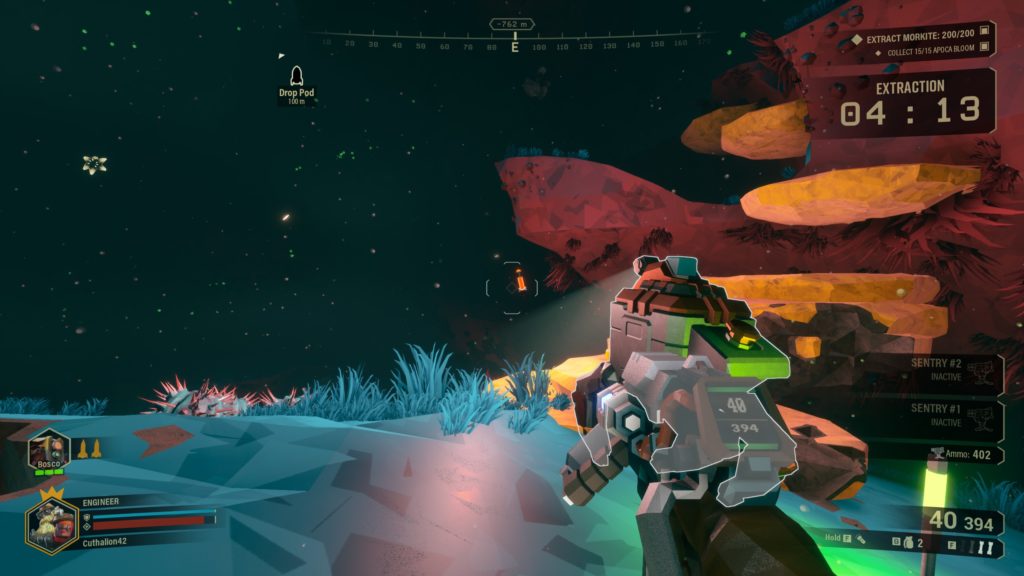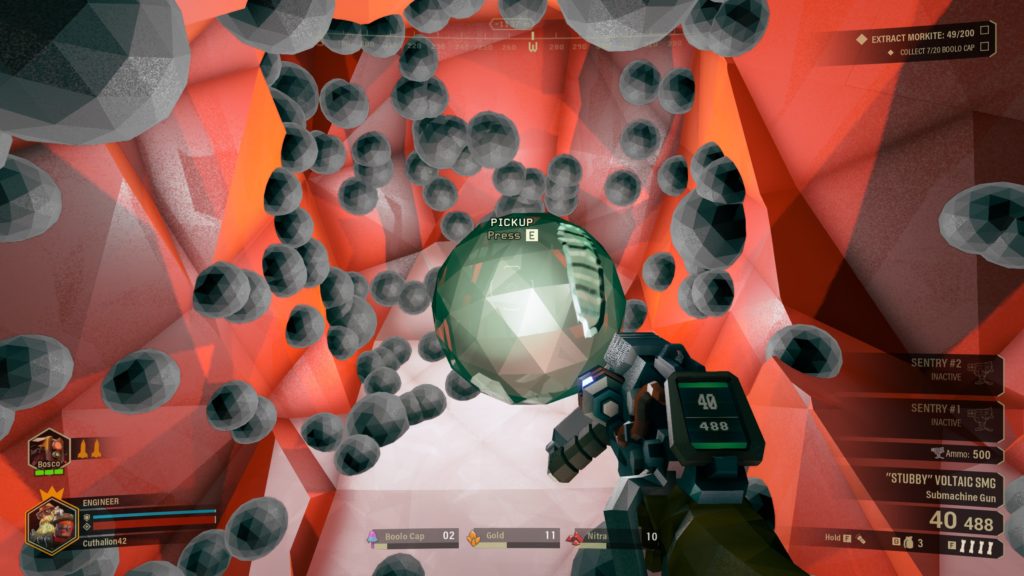Deep Rock Galactic, an early access title by developer Ghost Ship Games, is a cooperative FPS set on a hostile alien world. You are a dwarf who has enlisted with the Deep Rock Galactic mining corporation in search of riches and glory. Your job is to mine valuable resources from the planet Hoxxes IV, but be warned: the exceedingly dangerous climate, fauna, and even flora of Hoxxes dictate some highly unusual mining practices. All missions take the form of short excursions, arriving and exiting via drop pod, and all mining teams go heavily armed at all times. If you fail to reach extraction in time, you will be left behind. Brave the ever-encroaching darkness and hordes of Glyphids—a race of highly territorial space bugs—with a few trusty friends, and you just might make it out alive—or, better yet, strike it rich.

Where this game differs from other cooperative shooters is in the mission style. The levels are procedurally generated, which is actually a pretty interesting way of doing things. Sure, some missions can feel very similar because of this design, but no two will be exactly alike, and there is quite a bit of variety to keep things interesting. The mission board is laid out on a map with different regions and biomes, and each region will have a number of available missions. The way the missions are set up is very interesting. Aside from the different biomes (which I will discuss later), there are differing lengths and complexities for each mission–as well as several objective types–and sometimes they offer rare modifiers such as no shields and increased resources that will give you different bonuses upon completion. In addition, you can always increase the difficulty for another layer of challenge.

Deep Rock Galactic offers 4 playable classes, each of which has a unique loadout with weapons and support tools. Every character has infinite flares on cooldown for pushing back the darkness of the caves and a few grenades for emergency situations, but aside from that, they are completely different. The Scout, for instance, carries an assault rifle, a sawn-off shotgun, a grapple gun for quick traversal, and a flare gun with a limited number of extra-bright flares (very useful for illuminating large caverns); while the Gunner has a minigun, a powerful revolver, several temporary shield generators, and a gun that places permanent ziplines to help teammates reach difficult places. Each class, as of November, also has unlockable alternate weapons, which add an extra level of achievement and progression to the game.

In fact, most of the progression in Deep Rock Galactic comes from gadget upgrades and unlockable cosmetics. The upgrade system gives the player the chance to customize weapons and gadgets with mod slots. Each weapon has several mod slots, each with a choice between a few different upgrades. You can optimize your weapons for maximum damage, more accuracy, more ammo, a hybrid of these, or more; and some weapons offer some rather unique upgrades. The Engineer’s shotgun, for example, gives you a choice between Turret Whip, which lets you shoot your deployable turrets to give them a brief damage boost, and a full-auto mod that also increases fire rate. And the unlocking of cosmetic items is where a lot of the fun lies. Deep Rock Galactic offers a wide variety of visual customization, including beards, mustaches, hair/headgear, armor, skin color, hair color, and even a few eyebrows. Though you won’t see these on yourself very often (since it is a first-person game), the cosmetics allow you to create quite a few interesting looks for your character and provide a bit more to strive for in game.

One of the best parts of Deep Rock Galactic is the procedural generation used to craft the environments for each mission. Each biome feels unique, with differing flora, colors, and environmental hazards, and some missions even in the same biome can feel completely different. For instance, in the Fungus Bogs, sometimes you have long, twisting corridors with hanging vines that obscure vision, and other times you have more open chambers with slowing goo puddles and toxic plants. There are occasional problems, as with any procedural generation, but they are generally minor and far between. The environments are completely destructible, and the enemies are to a large extent as well. One of the most interesting parts of the combat in Deep Rock Galactic is the destructible carapaces of the Glyphids. Weapons with armor piercing will not only deal extra damage to protected parts of the aliens, but also break off shards of their outer shell, revealing the fleshy bits inside. If there is any criticism of the enemies to be had, I think the game would greatly benefit from adding a bit more variety in enemy types.

The art direction of Deep Rock Galactic is rather unusual, utilizing flat geometric planes to great effect, which makes the entire game look simplistic but interesting. The lack of curved surfaces also gives the game a timeless look, and I think it will age well. To flesh out the world even more, the lighting effects are extremely well-done, adding to the atmosphere of the dark caves and eerie alien environments of Hoxxes.

Overall, Deep Rock Galactic is good fun, especially with friends, and I would recommend giving it a try. I have certainly had a lot of fun with it, and I’ve come back again and again to be surprised by the positive changes and content the developers have added.
The Verdict:
The Game Factor: Is it fun? 9/10
The Look Factor: Is the Style or Graphics good? 10/10
The Friend Factor: Is the game good with friends? 10/10
The “Jump-In” Factor: Is the game easy to learn/hard to master? 8/10
The Total Score: 9/10

